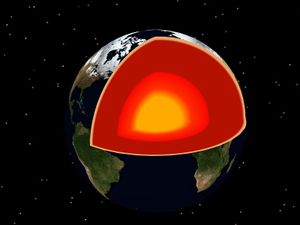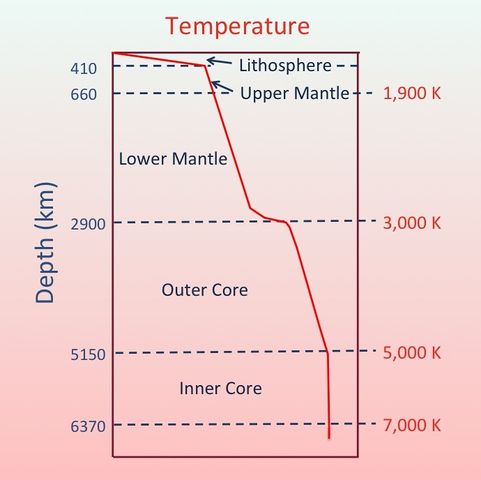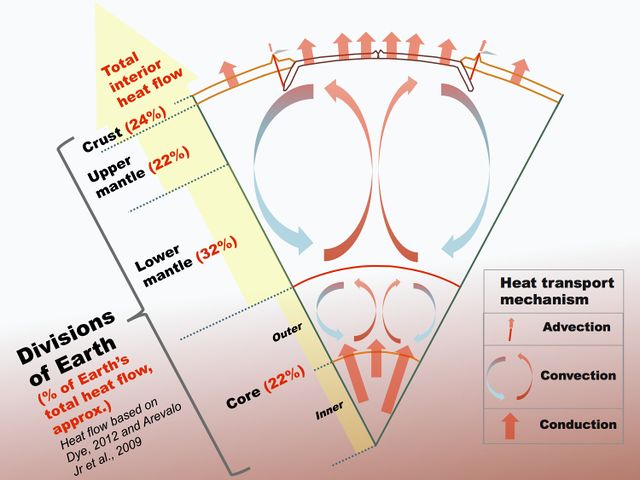Geothermal gradient: Difference between revisions
J.williams (talk | contribs) No edit summary |
J.williams (talk | contribs) m (1 revision imported) |
(No difference)
| |
Revision as of 21:31, 26 August 2015

Geothermal gradient is the amount the Earth’s temperature increases with depth, indicating heat flowing from the Earth’s warm interior to its surface.[2] On average, the temperature increases by about 25°C for every kilometer of depth.[3] This difference in temperatures drives the geothermal energy flows and allows humans to use this energy for heating and electricity generation. There are a number of places on the planet where the temperature changes quite a bit faster though, and that's almost always where geothermal energy is the most viable.
The interior of the Earth is extremely hot, and even reaches temperatures of over 5000°C towards the core, not much colder than the surface of the Sun (the interior of the sun however is much hotter).[4] In the 19th century it was predicted that the Earth should have cooled off just millions of years after its formation because of heat transfer mechanisms,[5] but the Earth has been around for thousands of times longer than that.
Where does this heat come from?
It was discovered in the early 20th century that the Earth's underground heat is from radioactive elements. Specifically, this heating is caused by the decay of elements such as potassium, uranium and thorium. These elements aren't found in the core however, with the most popular model suggesting that they are found in the lithosphere and mantle. This form of heating is said to account for 50% of the Earth's heat, with the other heat coming from the primordial heat of the Earth (heat from the Earth's formation).[6]
Figures 2 and 3 below shows the temperature increase with depth, along with how this heat flows. It can be seen that there is a drastic increase in the lithosphere/mantle due to the radioactive isotopes, and then it becomes rather steady towards the core.
- Earth's Temperature Gradient
Figure 2. Temperature profile of the Earth's layers. Temperature increases with depth.[7]
Figure 3. Heat transfer mechanisms within the Earth, along with the % amount of heat flow in each layer.[8]
See also
References
- ↑ Wikimedia Commons [Online], Available: https://commons.wikimedia.org/wiki/File:Blender3D_EarthQuarterCut.jpg
- ↑ Verbruggen, A., W. Moomaw, J. Nyboer, 2011: Annex I: Glossary, Acronyms, Chemical Symbols and Prefixes. In IPCC Special Report on Renewable Energy Sources and Climate Change Mitigation [O. Edenhofer, R. Pichs- Madruga, Y. Sokona, K. Seyboth, P. Matschoss, S. Kadner, T. Zwickel, P. Eickemeier, G. Hansen, S. Schlömer, C. von Stechow (eds)], Cambridge University Press, Cambridge, United Kingdom and New York, NY, USA.
- ↑ R. Wolfson, "Energy from Earth and Moon" in Energy, Environment, and Climate, 2nd ed., New York, NY: W.W. Norton & Company, 2012, ch. 8, pp. 204-224
- ↑ D. Alfè; M. Gillan & G. D. Price (January 30, 2002). "Composition and temperature of the Earth's core constrained by combining ab initio calculations and seismic data" (PDF). Earth and Planetary Science Letters (Elsevier) 195 (1–2): 91–98. Bibcode:2002E&PSL.195...91A. doi:10.1016/S0012-821X(01)00568-4.
- ↑ J.D. Burchfield, Lord Kelvin and the Age of the Earth, University of Chicago Press, 1990.
- ↑ Physics World. (2011). Radioactive decay accounts for half of Earth's heat [Online] Available: http://physicsworld.com/cws/article/news/2011/jul/19/radioactive-decay-accounts-for-half-of-earths-heat
- ↑ Wikimedia Commons [Online], Available: https://commons.wikimedia.org/wiki/File:Temperature_schematic_of_inner_Earth.jpg#/media/File:Temperature_schematic_of_inner_Earth.jpg
- ↑ Wikimedia Commons [Online], Available: https://commons.wikimedia.org/wiki/File:Heat_flow_of_the_inner_earth.jpg#/media/File:Heat_flow_of_the_inner_earth.jpg



